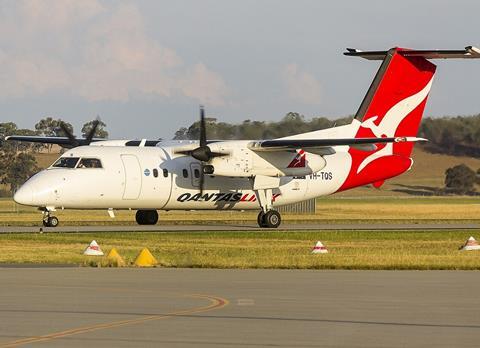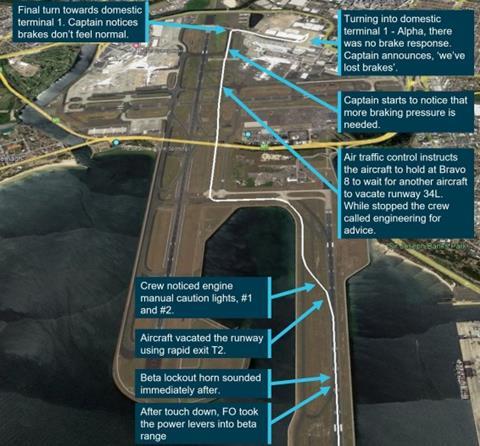Australian investigators have determined that a brake fire on a QantasLink De Havilland Dash 8-200, which triggered an evacuation, resulted from greater braking on landing, and was ultimately traced to a radio-altimeter failure during approach.
The aircraft (VH-TQS) had been descending through 17,500ft for its approach to Sydney on 8 November 2022 when the radio-altimeter failed.
This resulted in failure of the collision-avoidance system and ground-proximity warning system – both of which rely on the radio-altimeter – and generated alerts to the crew.
But radio-altimeter input is also crucial to a ‘beta lockout’ system which prevents the crew from retarding the throttles to the ‘beta’ range – which would activate reverse-thrust – during flight.
Below 50ft this lockout is inhibited by the radio-altimeter, enabling the crew to select reverse-thrust after landing. The aircraft’s weight-on-wheels sensors also inhibit the lockout.
Failure of the radio-altimeter meant the lockout system was relying solely on weight-on-wheels data as the aircraft touched down on runway 34R.

Flight-data recorder information shows that the weight-on-wheels sensors initially registered the aircraft as being on the ground but, as it settled, briefly switched back to indicating it was airborne.
This momentary change in signal caused the lockout system to activate just at the point when the first officer retarded the throttles to the ‘beta’ range in order to decelerate.
The lockout warning horn sounded, and the crew advanced the throttles out of the ‘beta’ range, to the flight-idle position, in order to silence it.
Lockout activation also resulted in the engines’ electronic control units reverting to manual mode. The crew was unable to use reverse-thrust, and had to maintain manually a propeller speed above 780rpm while braking and taxiing.
“This subsequently increased the amount of wheel braking required,” says the Australian Transport Safety Bureau.

The situation was exacerbated by a particularly long taxi route of some 5.5km, which included a downhill component. About halfway through this taxiing, the Dash 8 stopped at a holding point and the crew realised braking performance was deteriorating.
Although the aircraft continued to taxi, its brakes overheated and failed as it turned into the domestic parking area, and the captain manoeuvred to avoid colliding with another aircraft before bringing the Dash 8 to a halt.
“At that time, the cabin crew reported via the interphone that there was fire, including visible flames, from both sides of the aircraft,” says the inquiry, and the captain ordered an evacuation.
As the passengers disembarked, the first officer attempted to extinguish the fires on both main landing-gear, before emergency services arrived to apply foam suppressant.
None of the 24 passengers and three crew members was injured.
QantasLink responded to the incident by publishing technical advisory information to crews about the event, with details on the lockout system, along with a revised checklist to identify radio-altimeter failure. Revised procedures include ensuring positive weight-on-wheels during landing prior to retarding throttles to the ‘beta’ range.


























